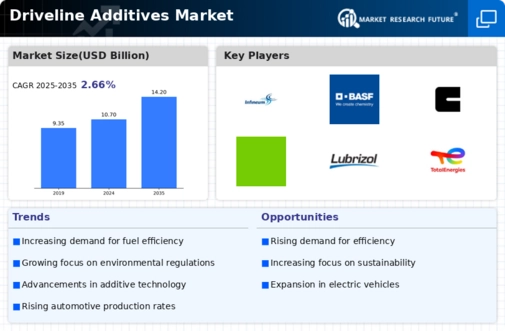Growing Automotive Industry
The expansion of the automotive industry plays a pivotal role in driving the Global Driveline Additives Market Industry. As vehicle production increases, the demand for driveline additives, which enhance performance and longevity, rises correspondingly. In 2024, the market is projected to reach 10.7 USD Billion, reflecting the industry's robust growth. This trend is particularly evident in emerging markets where vehicle ownership is on the rise. The integration of advanced technologies in vehicles necessitates the use of specialized driveline additives to ensure optimal performance, thereby propelling market growth.
Increased Focus on Vehicle Performance
The growing consumer emphasis on vehicle performance and longevity significantly impacts the Global Driveline Additives Market Industry. As consumers become more discerning, the demand for high-quality driveline additives that enhance vehicle efficiency and durability is on the rise. This trend is particularly pronounced in high-performance and luxury vehicle segments, where consumers are willing to invest in premium additives. The market's growth trajectory reflects this shift, with expectations of reaching 10.7 USD Billion in 2024. Manufacturers are responding by developing innovative formulations that cater to these performance-oriented consumers.
Technological Advancements in Additives
Technological innovations in driveline additives significantly influence the Global Driveline Additives Market Industry. The development of high-performance additives that improve fuel efficiency and reduce emissions aligns with global sustainability goals. For instance, advancements in synthetic additives provide superior lubrication and protection, which are crucial for modern drivetrains. As manufacturers increasingly adopt these technologies, the market is expected to grow, with projections indicating a rise to 14.2 USD Billion by 2035. This shift towards more efficient and environmentally friendly products suggests a promising future for the industry.
Expansion of Electric and Hybrid Vehicles
The increasing adoption of electric and hybrid vehicles is reshaping the Global Driveline Additives Market Industry. As these vehicles become more prevalent, there is a growing need for specialized driveline additives that cater to their unique requirements. This transition presents both challenges and opportunities for manufacturers, as they must innovate to meet the demands of this evolving market. The projected growth to 14.2 USD Billion by 2035 indicates a significant shift in consumer preferences and technological advancements. The industry is likely to adapt by developing additives that enhance the efficiency and performance of electric drivetrains.
Regulatory Compliance and Environmental Standards
Stringent regulatory frameworks regarding emissions and fuel efficiency are driving the Global Driveline Additives Market Industry. Governments worldwide are implementing stricter standards, compelling manufacturers to adopt driveline additives that comply with these regulations. This compliance not only enhances vehicle performance but also contributes to reduced environmental impact. As a result, the market is likely to experience sustained growth, with a projected CAGR of 2.66% from 2025 to 2035. The push for greener technologies is expected to further elevate the demand for specialized additives that meet these evolving standards.






















Leave a Comment